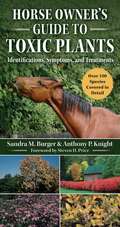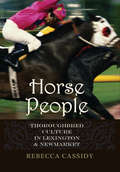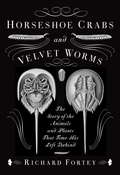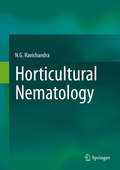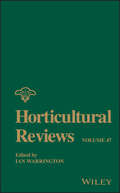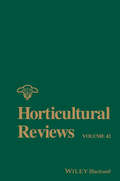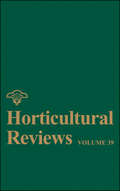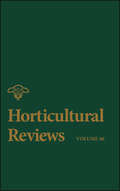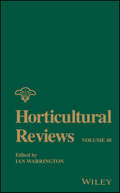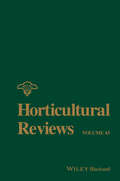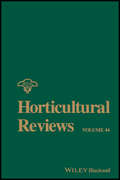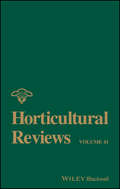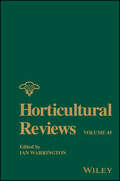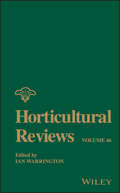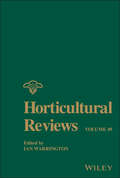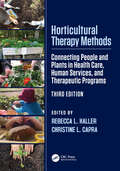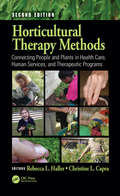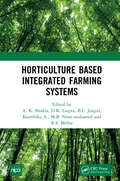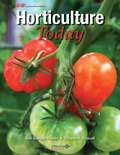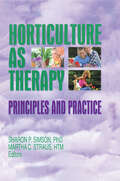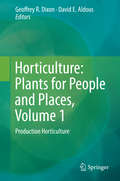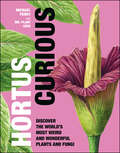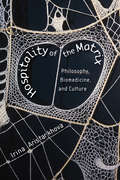- Table View
- List View
Horse Owner's Guide to Toxic Plants: Identifications, Symptoms, and Treatments
by Sandra McQuinnHorse Owner's Guide to Toxic Plants is a must-have, exclusive reference book for all horse owners, and the first of its kind on the subject of equines and plants. Keep this book in the medicine cabinet in the barn. Walk around the pastures with the book in hand, especially in late spring or early summer. Or pack it with on a trail ride. It just might save your horse's life.Horse Owner's Guide to Toxic Plants is organized according to types of plants—trees, bushes, shrubs, and vines, ferns and plants, weeds and wildflowers, and grasses and horsetails. Since visuals are very important for correct identification, clear color photographs are shown, including wherever possible a close-up photograph and line drawing to better identify each plant. Horsewoman Sandra McQuinn has researched and compiled information on more than 100 more common but toxic plants that grow in backyards, pastures, and on the range and trail. Also included is advice from a veterinarian on how to recognize the symptoms of poisonings in your horse and what steps you or your own veterinarian should take if you suspect your horse has eaten a toxic plant. Brimming with pertinent information and expert advice, Horse Owner's Guide to Toxic Plants is a must-have for all equine aficionados. No horse owner should be without it, including those who board their horses.
Horse People: Thoroughbred Culture in Lexington and Newmarket (Animals, History, Culture)
by Rebecca Louise CassidyThe world of Thoroughbred racing is glamorous, secretive, dangerous, and seductive—the sport of kings and the poor man's obsession. While the spectacle of racing stirs the imagination, it belies the ruthless business that lies beneath.This engaging original study demystifies this complex world by comparing centers of excellence in Britain and North America. Drawing from intensive field work in Suffolk's Newmarket and Kentucky's Lexington, Rebecca Cassidy gives us the inside track on all players in the industry—from the elite breeders and owners to the stable boys, racetrack workers, and veterinarians. She leads us through horse farms, breeding barns, and yearling sales; explains rigorous training regimens; and brings us trackside on race day.But the history of Thoroughbred racing culture is more than a collection of fascinating characters and exciting events. Cassidy's investigation reveals the factors—ethical, cultural, political, and economic—that have shaped the racing tradition.
Horse by Nature
by Mary Ann SimondsThe first complete reference to help equestrians make the changes needed to ensure social license and the ability to ride and compete horses for years to come. Renowned wild horse ecologist and equine behaviorist Mary Ann Simonds provides a practical soup-to-nuts manual for understanding how horses think, feel, learn, communicate, and interact with each other and with humans. Integrating over 30 years of field research, identifying functional social behaviors in wild horses with her lifelong professional practice working with equestrians solving equine behavioral issues, Simonds helps readers gain a strong foundation into the emotional and cognitive lives of horses and explore various horse-human relationships. She provides numerous tools for assessing personalities, communicating with horses, and understanding how horses learn, with an emphasis on improving care and reducing stress in competitions and sports. In three parts, each introduced by top researchers and scientists in the equestrian field, readers will: LEARN the natural history and social ecology of free-roaming wild horses. UNDERSTAND the instincts, learned behaviors, gender differences, social roles, and social bonds that are the driving factors in horse culture. DISCOVER how adaptable horses really are, and how that makes them an ideal species to share their social lives with humans. FOCUS on horse-human relationships applying the knowledge from Part One to reduce equine stress and improve communication in the management and training of all horses. EXPLORE how to better assess the horse&’s personality and emotions, understand his learning style, and use various communication channels to establish trust, improve friendship, and enhance performance. ADDRESS the ethics of horse sports and ask the questions needed to ensure horse welfare in all the disciplines. CONSIDER dozens of changes related to horse management and competition recommended by respected industry professionals. BE EMPOWERED to be an influencer to improve the lives of horses, whatever the profession, breed, or sport. Filled with hundreds of color-coded tips and beautiful photos, and backed by science, personal stories, and unique insights, readers have multiple ways to quickly find useful information and apply it to their own horse-human situations. Whether preparing for a horse show, working with young stock, riding on the trails, adopting a wild horse, running a rescue, or just hoping to improve your communication and relationships with all horses, this book is a catalyst for much-needed change in the equine industry.
Horseshoe Crabs and Velvet Worms
by Richard ForteyFrom one of the world's leading natural scientists and the acclaimed author of Trilobite!, Life: A Natural History of Four Billion Years of Life on Earth and Dry Storeroom No. 1 comes a fascinating chronicle of life's history told not through the fossil record but through the stories of organisms that have survived, almost unchanged, throughout time. Evolution, it seems, has not completely obliterated its tracks as more advanced organisms have evolved; the history of life on earth is far older--and odder--than many of us realize. Scattered across the globe, these remarkable plants and animals continue to mark seminal events in geological time. From a moonlit beach in Delaware, where the hardy horseshoe crab shuffles its way to a frenzy of mass mating just as it did 450 million years ago, to the dense rainforests of New Zealand, where the elusive, unprepossessing velvet worm has burrowed deep into rotting timber since before the breakup of the ancient supercontinent, to a stretch of Australian coastline with stromatolite formations that bear witness to the Precambrian dawn, the existence of these survivors offers us a tantalizing glimpse of pivotal points in evolutionary history. These are not "living fossils" but rather a handful of tenacious creatures of days long gone. Written in buoyant, sparkling prose, Horseshoe Crabs and Velvet Worms is a marvelously captivating exploration of the world's old-timers combining the very best of science writing with an explorer's sense of adventure and wonder.
Horticultural Nematology
by N. G. RavichandraThe major objective of this book is to highlight the significance of phytonematodes in horticulture. Detailed and latest information on major aspects of phytonematodes associated exclusively with horticultural crops, which is the need of the day, is lacking. Hence, the book has been written mainly with the objective of providing its readers, comprehensive information on the advanced aspects related to phytonematodes associated with horticultural crops. It also provides basic information on plant parasitic nematodes since it is required for a better understanding of advanced topics. Several popular topics, information on which is already available in plenty, have been avoided. Thus, book explicates both the essential fundamental and advanced aspects pertaining to nematodes associated with horticultural crops. The book is conveniently divided into 13 chapters, which cover latest information on the major fundamental and advanced aspects related to phytonematodes including the role of phytonematodes in horticultural industry, phylogenetic and evolutionary concepts in nematodes, major phytonematodes associated with horticultural crops and their diagnostic keys, symptoms caused by phytonematodes and disease diagnosis, nematode population threshold levels, crop loss assessment, nematode diseases of horticultural crops and their management, nematode disease complexes, genetics of nematode parasitism, important nematological techniques and nematodes of quarantine importance. An exclusive chapter on novel methods of nematode management has been included mainly to provide the information on the latest molecules and novel modes of managing nematodes attacking horticultural crops. Routine nematode management aspects, information on which is already available, have not been discussed; instead, this topic reflects the changing scenario of future nematode management. Hence, this book can serve as a friendly guide to meet the requirements of the students, teachers and researchers interested in these 'hidden enemies' of the grower, apart from the research and extension personnel working under Public organizations, officials of State departments of Horticulture, Forestry, field workers and all those concerned and working with plant parasitic nematodes. Appropriate diagrams, convincing tables and suitable graphs/illustrations have been furnished at right places. A complete bibliography has also been included.
Horticultural Reviews
by Ian WarringtonContents Contributors ix Dedication: Theodore DeJong xi 1. Molecular Physiology of Fruit Growth in Apple 1 2. Mechanosensing of Plants 43 3. Microgreens: Definitions, Product Types, and Production Practices 85 4. The Durian: Botany, Horticulture, and Utilization 125 5. The genus Cupressus L.: Mythology to Biotechnology with Emphasis on Mediterranean Cypress (Cupressus sempervirens L.) 213 6. Taxonomy and Botany of the Caricaceae 289 7. Entomopathogens: Potential to Control Thrips in Avocado, with Special Reference to Beauveria bassiana 325
Horticultural Reviews
by Jules JanickHorticultural Reviews presents state-of-the-art reviews on topics in horticultural science and technology covering both basic and applied research. Topics covered include the horticulture of fruits, vegetables, nut crops, and ornamentals. These review articles, written by world authorities, bridge the gap between the specialized researcher and the broader community of horticultural scientists and teachers
Horticultural Reviews (Horticultural Reviews #102)
by Jules JanickHorticultural Reviews presents state-of-the-art reviews on topics in horticultural science and technology covering both basic and applied research. Topics covered include the horticulture of fruits, vegetables, nut crops, and ornamentals. These review articles, written by world authorities, bridge the gap between the specialized researcher and the broader community of horticultural scientists and teachers.
Horticultural Reviews (Horticultural Reviews #104)
by Jules JanickHorticultural Reviews presents state-of-the-art reviews on topics in horticultural science and technology covering both basic and applied research. Topics covered include the horticulture of fruits, vegetables, nut crops, and ornamentals. These review articles, written by world authorities, bridge the gap between the specialized researcher and the broader community of horticultural scientists and teachers.
Horticultural Reviews (Horticultural Reviews)
by Ian WarringtonHorticultural Reviews presents state-of-the-art reviews on topics in horticultural science and technology covering both basic and applied research. Topics covered include the horticulture of fruits, vegetables, nut crops, and ornamentals. These review articles, written by world authorities, bridge the gap between the specialized researcher and the broader community of horticultural scientists and teachers.
Horticultural Reviews (Horticultural Reviews)
by Jules JanickHorticultural Reviews presents state-of-the-art reviews on topics in horticultural science and technology covering both basic and applied research. Topics covered include the horticulture of fruits, vegetables, nut crops, and ornamentals. These review articles, written by world authorities, bridge the gap between the specialized researcher and the broader community of horticultural scientists and teachers.
Horticultural Reviews Volume 43
by Jules JanickDedication: Chad E. FinnJohn R. Clark Light-Emitting Diodes in HorticultureC.A. Mitchell, J.F. Burr, M.J. Dzakovich, C. Gómez, R. Lopez, R. Hernández, C. Kutoba, C.J. Currey, Q. Meng, E.S. Runkle, C.M. Bourguet, R.C. Murrow, and A.J. Both Chayote: Pre-Columbian Origins and DispersaFernando A. Moreira Ragwort: Invasive Weed and Potential PharmaceuticalCatherina M. O'Keeffe, Gary W. Stutte, and Michelle McKeon-Bennett Advances and Trends in Organic Fruit and Vegetable Farming ResearchMartine Dorais and Beatrix Alsanius Western Botanical Gardens: History and EvolutionDonald A. Rakow and Sharon A. Lee The Future of Global Banana ProductionRandy C. Ploetz and Edward A. Evans
Horticultural Reviews, Horticultural Reviews
by Jules JanickHorticultural Reviews presents state-of-the-art reviews on topics in horticultural science and technology covering both basic and applied research. Topics covered include the horticulture of fruits, vegetables, nut crops, and ornamentals. These review articles, written by world authorities, bridge the gap between the specialized researcher and the broader community of horticultural scientists and teachers.
Horticultural Reviews, Volume 45
by Ian WarringtonHorticultural Reviews presents state-of-the-art reviews on topics in horticultural science and technology covering both basic and applied research. Topics covered include the horticulture of fruits, vegetables, nut crops, and ornamentals. These review articles, written by world authorities, bridge the gap between the specialized researcher and the broader community of horticultural scientists and teachers.
Horticultural Reviews, Volume 46 (Horticultural Reviews)
by Ian WarringtonHorticultural Reviews presents state-of-the-art reviews on topics in horticultural science and technology covering both basic and applied research. Topics covered include the horticulture of fruits, vegetables, nut crops, and ornamentals. These review articles, written by world authorities, bridge the gap between the specialized researcher and the broader community of horticultural scientists and teachers.
Horticultural Reviews, Volume 49 (Horticultural Reviews)
by Ian WarringtonHorticultural Reviews Contents Contributors vii Dedication: Dr. Christopher B. Watkins xi Oakleaf Hydrangea (Hydrangea quercifolia Bartr.): Horticulture, Genetics, Breeding, and Conservation 1 Biostimulants in Agricultural and Horticultural Production 35 Postharvest Physiological Disorders of Banana Fruit: Finger Drop, Senescent Spotting, and Chilling Injury 97 Mechanical Harvesting of Selected Temperate and Tropical Fruit and Nut Trees 171 Apple Fruitlet Abscission Mechanisms 243
Horticultural Therapy Methods: Connecting People and Plants in Health Care, Human Services, and Therapeutic Programs
by Rebecca L. Haller and Christine L. CapraHorticultural Therapy Methods: Connecting People and Plants in Health Care, Human Services, and Therapeutic Programs was the first text to describe the processes and techniques used to provide horticultural therapy interventions, and the rationale for their use. The first edition was written to positively impact the professional practice of horticultural therapy and provide an array of strategies for horticultural therapy treatment. Prior to its publication, the topics had only been addressed by other allied professions but had not been specifically tailored for horticultural therapy. The second edition updated the material, added essential information on planning treatment sessions, and provided techniques to address treatment issues for mental health, physical health, vocational skills, and wellness. This third edition revises all chapter content, improves and expands appendices, adds a chapter on building relationships, provides new photos, and includes additional case examples, in addition to providing discussion questions, references, further reading, and key concepts.Horticultural Therapy Methods is a clear instructive manual that explains: The process of treatment planning in horticultural therapy Session development, including activity or task selections to meet treatment objectives Therapeutic use of self and relationship building Motivation and behavior management techniques Adaptations and modifications to enable and challenge program participants How to maximize active engagement in horticulture and cultivation of plants Treatment documentation guidelines Practical approaches for mental health and other areas of practice Horticultural Therapy Methods: Connecting People and Plants in Health Care, Human Services, and Therapeutic Programs, Third Edition, is a reference and guide for students, educators, and those using horticulture for therapeutic purposes to help construct effective treatment programs. Health care and human service professionals can use this reference in the therapy, treatment, and education of inmates, residents, patients, trainees, students and others. The aim of this book is to guide novice and experienced horticultural therapists to use accepted human service practices that are aligned with allied professions.
Horticultural Therapy Methods: Connecting People and Plants in Health Care, Human Services, and Therapeutic Programs, Second Edition
by Rebecca L. Haller Christine L. CapraHorticultural therapy has evolved from its use only by volunteer gardeners to become a recognized and respected therapeutic modality conducted by trained, registered professionals. Horticultural Therapy Methods is the first textbook to describe the processes and techniques used to provide horticultural therapy interventions and the rationale for their use. This book presents types of programs, settings, and goals in horticultural therapy. It outlines treatment planning; development of sessions to meet treatment objectives; motivation and behavior management techniques; documentation guidelines; practical approaches for wellness; and resources for activity ideas. New to this Edition: Various useful examples of horticultural therapy in practice and strategically placed tips and resources. Additions to appendix on horticultural therapy treatment strategies. New chapter on session planning. Thirty-seven photographs demonstrating horticultural therapy in practice. Additional "HT Practice" examples and tips. The book is used as a reference and a guide for students, educators, and those conducting horticultural therapy or therapeutic horticulture to guide them in constructing effective treatment programs. Health care and human service professionals use the reference in the therapy, treatment, and education of inmates, residents, patients, trainees, students, and other participants.
Horticulture Based Integrated Farming Systems
by A. K. Shukla D. K. Gupta B. L. Jangid Keerthika A. R. S. Mehta M.B. Noor mohamedThe content of this book provides information on advanced knowledge in the sphere of importance and scope of horticulture in India, horticulture based integrated farming systems, integration of livestock in horticulture based farming systems, emerging issues, natural resource management, disease and pest management, organic farming and certification, post-harvest measures and value addition in arid fruits and vegetables, marketing aspects, status and export promotion measures and procedures. Note: T&F does not sell or distribute the hardback in India, Pakistan, Nepal, Bhutan, Bangladesh and Sri Lanka. This title is co-published with NIPA.
Horticulture Today
by Jodi Songer Riedel Elizabeth DriscollAn all-new option for introductory horticulture or plant science courses, Horticulture Today engages students with practical information they can use and hands-on activities they perform. Written by two dynamic agriculture educators, the text presents a contemporary overview of the horticulture industry, then provides thorough coverage of plant science, horticultural practices, landscape design and maintenance, and integrated pest management. In developing an appreciation for the diversity and global context of horticulture, Horticulture Today helps students to develop literacy in Green Industry careers as well as the skills they will need to succeed.
Horticulture as Therapy: Principles and Practice
by Sharon Simson Martha StrausDid you know that plants and plant products can be used to improve people’s cognitive, physical, psychological, and social functioning? Well, they can, and Horticulture as Therapy is the book to show you how! If you are already familiar with the healing potential of horticultural therapy, or even practice horticultural therapy, this book will help you enrich your knowledge and skills and revitalize your practice. You will learn how horticultural therapy can be used with different populations in a variety of settings, what resources are available, effective treatment strategies, and the concepts behind horticultural treatment.The first comprehensive text on the practice of horticulture as therapy, this one-of-a-kind book will enable the profession to educate future horticultural therapists with fundamental knowledge and skills as they embark on careers as practitioners, researchers, and educators. You come to understand the relationship between people and plants more deeply as you learn about: vocational, social, and therapeutic programs in horticulture special populations including children, older adults, those who exhibit criminal behavior, and those with developmental disabilities, physical disabilities, mental health disorders, or traumatic brain injury use of horticultural therapy in botanical gardening and community settings adaptive gardening techniques applied research documentation and assessment in horticultural practice Horticulture as Therapy establishes, integrates, and communicates a foundation of knowledge for horticultural therapists, other therapists, horticulturists, students, research scientists, gardeners, and others interested in this special and unique kind of therapy. By reading Horticulture as Therapy, you will see how you can make a difference in the health and well-being of so many people, today and tomorrow.
Horticulture: Plants for People and Places, Volume 2
by Geoffrey R. Dixon David E. AldousThis Trilogy explains "What is Horticulture?". Volume two of Horticulture: Plants for People and Places analyses in depth the scientific, managerial and ecological concepts which underpin Environmental Horticulture. Chapters describe: Horticulture and the Environment, Woody Ornamentals, Herbs and Pharmaceuticals, Urban Greening, Rural Trees, Urban Trees, Turfgrass Science, Interior and External Landscaping, Biodiversity, Climate Change and Organic Production. Each is written by leading international experts. Sustainable use of resources and careful conservation are critically essential for the continuation of life on this Planet. Achieving this is where horticulture, natural flora and fauna and the environment interact in achieving sustainable development. Horticulture is the fundamental partner of ecological and environmental science and provides an understanding of eco-system services. Live plant networks are essential for rural and urban life. They are integral parts of natural communities, the context of historic and modern architecture and a means for rejuvenating cities and uniting communities. Plants provide urban, peri-urban and rural employment, business and tourism opportunities, leisure, rest and relaxation. These facets of Environmental Horticulture are clearly described in this book.
Hortus Curious: Discover the World's Most Weird and Wonderful Plants and Fungi
by Michael PerryCelebrate the weird, wacky, and wonderful world of plants with a book that revels in the diversity of the botanical world.Plants are truly awe-inspiring. They can be vast, minute, smelly, or spectacularly ugly. Some plants live on their own, or by growing off others; some live by air and water; others are carnivorous, eating the creatures around them; some plants look remarkably like animals; while others have unusual symbolism; and some have special cultural significance. This book explores them all, bringing together the most peculiar and most fascinating plants on the planet – celebrating them in all their diverse splendor.Split into five chapters, covering everything from poisonous plants to painkilling ones, Michael Perry explains exactly what makes each plant special. With exquisitely detailed illustrations of all the different species, this is an informative, humorous, and beautiful gift for all those who love plants – whether they want to grow them or not. Hortus Curious delivers a different way to view the plant world and enjoy it for its bonkers and bizarre.The book is split into five chapters, covering:- Plants Behaving Badly – the criminal world of plants such as poisonous plants, insect catching plants, and plants that do risky thing- Mistaken Identity – plants that look like other things, e.g. flowers that look like monkeys, bees, or even dead man&’s fingers- Greater Good – did you know that aspirin comes from a plant? This chapter explores the plants that make up our everyday products- Superheroes – find out about the plants that can disguise themselves, changing color, shape or even moving themselves- X-rated Plants – a selection of the rudest plants out there!A humorous and quirky gift book for people interested in plants and gardening, Hortus Curious is sure to delight.
Hospitality Security: Managing Security in Today's Hotel, Lodging, Entertainment, and Tourism Environment
by Darrell CliftonA security director must have knowledge of criminal and civil law, risk and personnel management, budgeting and finance, and a host of other areas in order to be effective. Hospitality Security: Managing Security in Today's Hotel, Lodging, Entertainment, and Tourism Environment provides experience-based, proven methods for preventing and resolving the challenges faced by today's hospitality practitioner. Designed for both novice security professionals and industry veterans in need of a reference, the book covers: Risk assessment, where threats and vulnerabilities are calculated with probabilities to determine risk The security plan, where you decide how to apply various layers of control to mitigate the risks Budgeting: the amount of money available to implement the plan determines the next step Policies: how to document policies into a security manual, training manual, emergency procedures manual, and incident action plan Staffing: scheduling, wages, deployment, and contract security Training, including specialized topics such as use of force and bike patrol Physical security and patrol procedures Alarm and camera systems and various software programs Emergency procedures and response Investigations, interviews, and crime analysis Executive skills: learning from proven leadership styles Ideal for novices and veterans alike, this accessible, reader-friendly primer enables security directors to evaluate what risks are inherent to hospitality environments, analyze those risks through threat and vulnerability assessments, and develop methods to mitigate or eliminate them-all the while keeping customers and personnel safe and improving the bottom line.
Hospitality of the Matrix: Philosophy, Biomedicine, and Culture
by Irina AristarkhovaThe question "Where do we come from?" has fascinated philosophers, scientists, and artists for generations. This book reorients the question of the matrix as a place where everything comes from (chora, womb, incubator) by recasting it in terms of acts of "matrixial/maternal hospitality" producing space and matter of and for the other. Irina Aristarkhova theorizes such hospitality with the potential to go beyond tolerance in understanding self/other relations. Building on and critically evaluating a wide range of historical and contemporary scholarship, she applies this theoretical framework to the science, technology, and art of ectogenesis (artificial womb, neonatal incubators, and other types of generation outside of the maternal body) and proves the question "Can the machine nurse?" is critical when approaching and understanding the functional capacities and failures of incubating technologies, such as artificial placenta. Aristarkhova concludes with the science and art of male pregnancy, positioning the condition as a question of the hospitable man and newly defined fatherhood and its challenge to the conception of masculinity as unable to welcome the other.
